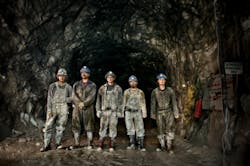MSHA Promulgates Final Rule to Lower Miners’ Exposure to Respirable Coal Dust
MSHA has issued a final rule aimed at lowering miners’ exposure to respirable coalmine dust in underground and surface coalmines.
The final rule, which MSHA published in the May 1 Federal Register, is part of the agency’s “End Black Lung – Act Now” campaign to eliminate black lung disease, a debilitating illness that continues to affect coal miners and their families.
According to MSHA, the final rule lowers levels of miners’ exposure to respirable coalmine dust and further reduces dust exposure by closing loopholes and improving sampling practices to better reflect actual working conditions and protect all miners from overexposures.
MSHA asserted that the rule has “a common-sense phase-in over a two-year period to give the industry the time it needs to adjust to the new requirements, acquire monitoring equipment and obtain compliance assistance from MSHA.”
“This final rule fulfills a longstanding commitment that I made on my first day with MSHA, and one to which I have been dedicated most of my working life,” MSHA Administrator Joseph Main said. “We are finally moving forward to overhaul an outdated program that has failed to adequately protect miners from breathing unhealthy levels of coalmine dust and achieving the intent of Congress to eliminate black lung disease.”
Long Time in the Making
Since publishing a proposed rule in October 2010, MSHA noted that it has held seven public hearings, extended the comment period three times and received approximately 2,000 pages of comments from industry, labor, public health professionals, academia and others.
“In developing the final rule, we carefully considered public comments and applied a strategic approach,” Main said. “It is the product of years of MSHA’s efforts to improve health protections for coalminers.”
The final rule:
- Reduces the overall dust standard from 2 to 1.5 milligrams per cubic meter of air and cuts in half the standard from 1 to 0.5 for certain mine entries and miners with pneumoconiosis.
- Requires immediate action when dust levels are high instead of allowing days or weeks of miners’ exposure to unhealthy dust.
- Requires more frequent sampling of areas known to have relatively high dust levels, such as those closest to the production area.
- Changes the method of averaging dust samples, which previously allowed miners on some shifts to be exposed to levels above the standard.
- Requires sampling for the full shift a miner works to ensure protection for all working hours, rather than stopping measurement after eight hours, as under the previous requirement.
- Requires that, for MSHA-collected samples, MSHA will issue a citation for any single, full-shift sample at or exceeding the citation level.
- Requires dust samples to be taken when mines are operating at 80 percent of production, as opposed to the previous 50 percent requirement, so that samples are more representative of actual working conditions.
- Requires mine operators to conduct thorough on-shift examinations of dust controls and verify controls with written certification.
- Improves medical surveillance of miners.
Prolonged exposure to respirable coalmine dust causes lung diseases such as coal workers’ pneumoconiosis, emphysema and progressive massive fibrosis. The diseases – collectively referred to as black lung – can lead to permanent disability and death.
According to NIOSH estimates, more than 76,000 miners have died since 1968 as the result of the disease, and more than $45 billion in federal compensation benefits have been paid out to coalminers disabled by black lung and their survivors. Evidence indicates that miners, including young miners, continue to be diagnosed with the disease.
“Today we advance a very basic principle: You shouldn’t have to sacrifice your life for your livelihood,” U.S. Secretary of Labor Thomas Perez said at an April 23 event at NIOSH’s Morgantown, W.V., facility. “But that’s been the fate of more than 76,000 miners who have died at least in part because of black lung since 1968. I believe we can have both healthy miners and a thriving coal industry. The nation made a promise to American miners when we passed the Coal Act in 1969 – with today’s rule we’re making good on that promise.”
